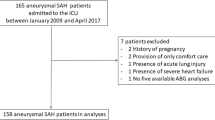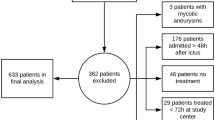Abstract
We retrospectively examined partial arterial pressure of oxygen (Pao2) afer subarachnoid hemorrhage (SAH), adjusted for patient-related risk factors for hypoxemia in 51 adult patients with no disturbance of consciousness undergoing surgery for clipping of intracranial aneurysms. A control group of 174 patients undergoing other operations were used for comparison. Arterial blood gas analysis was performed while patients were spontaneously breathing room air in the supine position before induction of anesthesia. The Pao2 in the SAH patients was significantly lower (p<0.0001) than that in the control group after adjustment for age, obesity, and smoking status. In three patients in the SAH group, Pao2 was less than 60 mmHg. Close monitoring of arterial oxygenation with pulse oximetry is desirable, and supplemental oxygen should be considered during transfer from the patients' room to the operating suite, even for conscious patients of SAH without cardiopulmonary disease.
Similar content being viewed by others
References
Moseley RV, Doty DB (1970) Hypoxemia during the first twelve hours after battle injury. Surgery 67:765–772
Katsurada K, Yamada R, Sugimoto T (1973) Respiratory in sufficiency in patients with severe head injury. Surgery 73: 191–199
Sinha RP, Ducker TB, Perot PL Jr (1973) Arterial oxygenation. Findings and its significance in central nervous system trauma patients. JAMA 224:1258–1260
Weisman SJ (1939) Edema and congestion of the lungs resulting from intracranial hemorrhage. Surgery 6:722–729
Ciongoli AK, Poser CM (1972) Pulmonary edema secondary to subarachnoid hemorrhage. Neurology 22:867–870
Ducker TB (1968) Increased intracranial pressure and pulmonary edema. 1. Clinical study of 11 patients. J Neurousurg 28:112–117
Schumacker PT, Rhodes GR, Newell JC, et al. (1979) Ventilation-perfusion imbalance after head trauma. Am Rev Respir Dis 119:33–43
Theodore J, Robin ED (1976) Speculations on neurogenic pulmonary edema (NPE). Am Rev Respir Dis 113:405–411
Schlesselman JJ (1982) Sources of bias case-control studies. Oxford University Press, New York, pp 124–143
Marshall BE, Wyche MQ Jr (1972) Hypoxemia during and after anesthesia. Anesthesiology 37:178–209
Kitamura H, Sawa T, Ikezono E (1972) Postoperative hypoxemia: the contribution of age to the maldistribution of ventilation. Anesthesiology 36:244–252
Said SI (1960) Abnormalities of pulmonary gas exchange in obesity. Ann Intern Med 53:1121–1129
Tyler IL, Tantisira B, Winter PM, et al. (1985) Continuous monitoring of arterial oxygen saturation with pulse oximetry during transfer to the recovery room. Anesth Analg 64:1108–1112
Strieder DJ, Murphy R, Kazemi H (1969) Mechanism of postural hypoxemia in asymptomatic smokers. Am Rev Respir Dis 99: 760–766
Moller JT, Wittrup M, Johansen SH (1990) Hypoxemia in the postanesthesia care unit: an observer study. Anesthesiology 73:890–895
Hunt WE (1974) Timing and perioperative care in intracranial aneurysm surgery. Clin Neurosurg 21:79–89
Greenland S (1989) Modeling and variable selection in epidemiologic analysis. Am J Public Health 79:340–349
Denny-Brown D, Russel WR (1941) Experimental cerebral concussion. Brain 64:93–164
Nunn JF (1965) Influence of age and other factors on hypoxemia in the postoperative period. Lancet 2:466–468
Vaughan RW, Engelbirdt RD, Wise L (1974) Postoperative hypoxemia in obese patients. Ann Surg 180:877–882
Gerrard JW, Cockcroft DW, Mink JJ, et al. (1980) Increased nonspecific bronchial reactivity in cigarette smokers with normal lung function. Am Rev Respir Dis 122:577–581
Suzuki J, Onuma T, Yoshimoto T (1979) Results of early operation on cerebral aneurysm. Surg Neurol 11:407–412
Yoshimoto T, Uchida K, Kaneko U, et al. (1979) An analysis of follow-up results of 1000 intracranial saccular aneurysms with definitive surgical treatment. J Neurosurg 50:152–157
Fisher A, Abol-Nasr HT (1979) Delayed nonfatal pulmonary edema follwing subarachnoid hemorrhage. J Neurosurg 51:856–859
Nishiwaki K, Ishikawa N, Hirabayashi A, et al. (1993) Neurogenic pulmonary edema (in Japanese). Shuchuchiryo (Intensive Care) 5:985–991
Author information
Authors and Affiliations
About this article
Cite this article
Oshima, S., Sugihara, K. & Wakayama, S. Preoperative hypoxemia in conscious patients after subarachnoid hemorrhage. J Anesth 8, 420–424 (1994). https://doi.org/10.1007/BF02514620
Received:
Accepted:
Issue Date:
DOI: https://doi.org/10.1007/BF02514620




